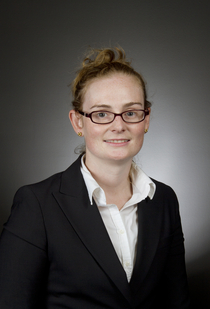Jun 6 2013
Chemical engineer Mary Laura Lind is set to begin research this summer aimed at driving advances in water purification, wastewater recovery, biofuel production and energy sustainability.
 ASU chemical engineer Mary Laura Lind’s research will be used as the basis for education outreach to middle school students. Photo by: Jessica Slater/ASU
ASU chemical engineer Mary Laura Lind’s research will be used as the basis for education outreach to middle school students. Photo by: Jessica Slater/ASU
The project is supported by a National Science Foundation (NSF) CAREER Award Lind won earlier this year. The award is given to young engineers and scientists who are demonstrating the potential to be research and education leaders in their fields.
Lind is an assistant professor in the School for Engineering of Matter, Transport and Energy, one of the Ira A. Fulton Schools of Engineering at Arizona State University.
The NSF award comes with a grant of $400,000 to be distributed over five years. It will enable Lind to assemble a team primarily of engineering graduate students, aided by undergraduates, to conduct research under her direction.
The project will focus on better understanding the fundamental transport properties of composite membranes at the nanoscale.
The goal is to apply the findings to a variety of processes that require separation of chemicals from water and volatile organic compounds using filtering devices called membranes. Lind’s team will create new membranes using nontraditional materials.
The team hopes to develop combinations of new materials and membrane designs that will improve water-purification and wastewater-treatment processes, as well as filter out materials from solutions that can be used to produce biofuels.
Lind is specifically interested in advancing the process of making butanol fuel. “It’s better than ethanol,” she says, “because it’s less corrosive to infrastructure,” such as pipelines and storage tanks, and has a higher energy density – meaning there is more stored energy in butanol than in equal volumes of ethanol.
The project also will delve into solutions to the “energy/water nexus.” As Lind explains, “It takes a lot of energy to manage and treat water, and it takes a lot of water to produce energy.” Her goal is to improve filtration and transport methods in ways that make such a process more energy efficient and require less water consumption.
“Her work on membranes for liquid phase applications, especially water purification and treatment, is an important part of ASU’s overall research thrust in energy and sustainability,” says ASU chemical engineering Regents’ Professor Jerry Lin, an internationally recognized pioneer in inorganic membrane science.
Lind’s NSF Career award “not only recognizes her for accomplishments in membrane research, but also boosts her endeavor to become a research and education leader in this area,” he says.
Professor Kyle Squires, director of the School for Engineering of Matter, Transport and Energy, says Lind’s NSF CAREER Award “is a terrific accomplishment, and one that we are especially pleased with because the research is at the forefront of membrane science and also because of the education outreach efforts that will provide unique experiences to spark interest in STEM (science, technology, engineering and math) subjects among students at all levels.”
Aspects of Lind’s work will be used as the basis for educational outreach programs. She is working with a Phoenix charter school teacher to develop a series of class lessons in basic science and engineering for students in sixth through eighth grades.
Lind will also offer young students an opportunity to get involved in her lab’s work through the high school research intern program run by ASU’s engineering schools.
Lind is already involved in similar research efforts through a $200,000-per-year grant over three years she was awarded by the National Aeronautics and Space Administration. The NASA grant supports her research to improve technologies for wastewater recovery and water recycling systems designed for use in space stations and other space vehicles.
Lind earned a bachelor’s degree in chemical engineering from Yale University, followed by a master’s degree and a doctoral degree in materials science from the California Institute of Technology (Caltech).
She joined the ASU faculty after completing a California Nanosystems Institute Pioneer Postdoctoral Fellowship at the University of California, Los Angeles. She is now also a senior sustainability scientist with ASU’s Global Institute of Sustainability.